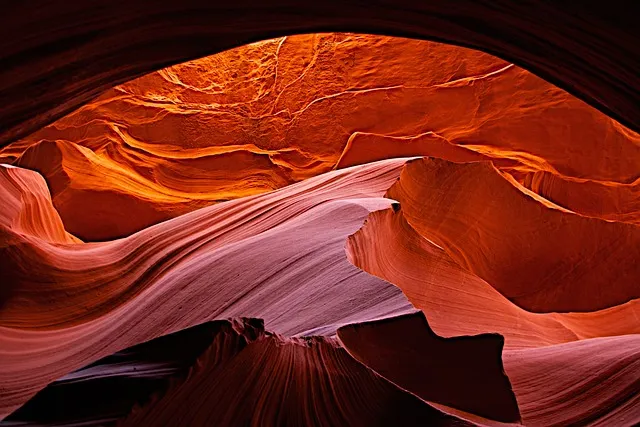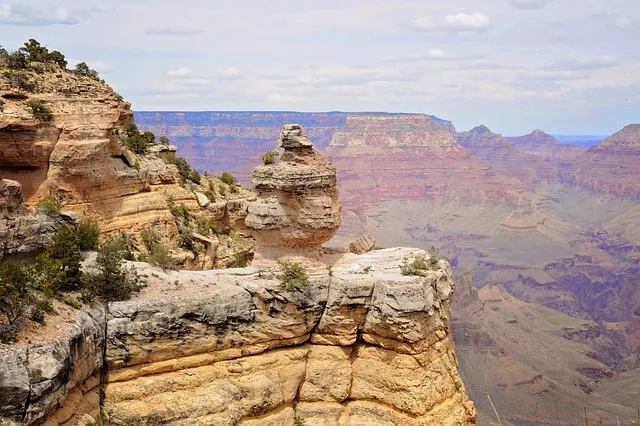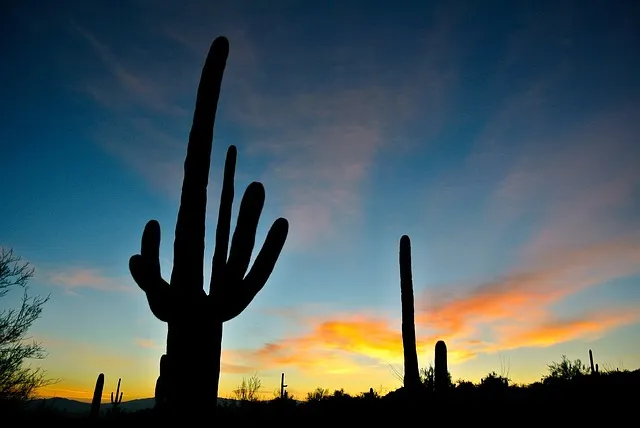Arizona's deserts, including the Sonoran, Mojave, and Great Basin Deserts, are known for their distinctive ecosystems and unique biodiversity. The state's iconic landscapes host a variety of adapted species such as saguaros, Joshua trees, and desert bighorn sheep, and provide recreational spaces like Saguaro National Park, which showcases the resilience of desert flora and fauna. Phoenix and Tucson blend urban life with natural beauty, offering residents and tourists a mix of cultural experiences, outdoor activities, and access to national parks. These cities highlight Arizona's ability to integrate historical sites, vibrant arts scenes, and culinary delights with the state's stunning desert environments.
Arizona’s landscapes present a captivating array of environments, from arid deserts to vibrant urban centers. This article delves into the state’s unique natural beauty and urban green spaces, offering insights into the diverse desert environments of Saguaro National Park, the rich ecosystems of the Sonoran Desert, and the lush oases found within Phoenix’s cityscape. It also explores how Arizona’s cities blend natural splendor with contemporary comforts. Join us as we traverse these contrasting terrains, uncovering the interplay between nature and civilization that makes Arizona a destination of both wonder and vitality.
- Arizona's Diverse Desert Environments
- Saguaro National Park: Giant Cacti and Rich Ecosystems
- Sonoran Desert Flora and Fauna Highlights
- Urban Oases: Phoenix's Green Spaces Amidst the City
- Exploring Arizona's Cities: A Blend of Natural Beauty and Modern Life
Arizona's Diverse Desert Environments

Arizona’s diverse desert environments encompass a range of distinct ecosystems, each with its unique characteristics and biodiversity. The Sonoran Desert, the most biologically diverse desert in North America, stretches across the southern part of the state. It is home to iconic species such as the saguaro cactus, which can live for up to 200 years, and the prickly pear cactus, known for its edible fruit. This desert boasts a remarkable array of life forms, including the elusive desert bighorn sheep and an impressive variety of reptiles and birds that have adapted to the arid conditions. To the north, the Mojave Desert, characterized by its Joshua trees and cooler winters, presents a different landscape with its own set of endemic species and geological wonders like the Black Rock Desert and Death Valley’s Racetrack Playa, famed for its moving rocks. The Great Basin Desert, found primarily in the northern part of Arizona, is known for its high elevation and rugged terrain, offering a different desert experience with its unique flora and fauna adapted to the mountainous conditions. These distinct deserts within Arizona provide vital habitats and a rich tapestry of natural beauty that contrast sharply with the state’s urban environments, highlighting the dynamic nature of Arizona’s ecological diversity.
Saguaro National Park: Giant Cacti and Rich Ecosystems

Arizona’s desert landscapes are home to one of the most iconic symbols of the American Southwest – the saguaro cactus. Within the boundaries of Saguaro National Park, visitors encounter vast expanses where these towering giants dot the landscape, their branches outstretched towards the sky in a silent gesture of perseverance. These majestic cacti are not mere plants; they are integral components of a rich and diverse ecosystem that sustains a myriad of wildlife. The park’s two distinct districts, the Tucson Mountain District to the west and the Rincon Mountain District to the east, offer a window into the desert’s resilience and beauty. The saguaro cacti, with their spiral-shaped arms, can live up to 200 years and grow to over 40 feet in height, providing habitat for animals like the desert tortoise and the elfin woodpecker. The park also boasts a variety of other plant species that flourish under the hot sun, including prickly pear cacti, cholla cacti, and an assortment of desert shrubs that paint the landscape with splashes of green, purple, yellow, and red. As the sun sets, the park transforms, casting a golden glow over the undulating terrain that beckons photographers and nature enthusiasts alike. The Saguaro National Park is not just a testament to the resilience of life in arid environments but also a sanctuary where visitors can experience the raw essence of the American desert.
Sonoran Desert Flora and Fauna Highlights

The Sonoran Desert, nestled within Arizona, is a veritable hotspot for diverse flora and fauna, showcasing an array of life adapted to arid conditions. The flora of this desert is particularly noteworthy for its resilience; species like the saguaro cactus, with its towering stature, and the prickly pear cactus, bearing edible fruits, are iconic. These plants have evolved to conserve water through various strategies such as storing it in their tissues or shedding leaves to minimize photosynthesis needs. The fauna of the Sonoran Desert is equally impressive, featuring creatures like the desert bighorn sheep, which thrives on a diet of creosote bush and Mormon tea, and the Gila monster, a unique venomous lizard that feeds on insects and small mammals. The desert’s ecosystem is further enriched by the presence of the coati, roadrunners, and a variety of rattlesnakes, each playing a role in the intricate web of life within this harsh yet beautiful environment. The interplay of these species creates a dynamic ecosystem where survival is paramount, and adaptation to the desert’s extremes is the key to success. This biodiversity is not only a natural wonder but also a testament to the resilience and adaptability inherent in the Sonoran Desert’s ecological community.
Urban Oases: Phoenix's Green Spaces Amidst the City

Phoenix, Arizona’s capital and most populous city, is renowned for its expansive urban oases that provide a refreshing contrast to the desert surroundings. These verdant spaces are not mere patches of greenery but vital havens for both residents and visitors seeking respite from the arid heat. The city boasts an impressive array of parks and gardens that serve as natural air conditioners, offering a cool escape through lush vegetation, shaded walking paths, and serene water features. Papago Park, with its iconic red buttes and Hole-in-the-Rock formation, is a prime example, providing recreational activities from hiking and mountain biking to picnicking and golfing. Desert Botanical Garden showcases the unique Sonoran Desert flora, educating visitors on the adaptability of desert plants and their importance in sustaining life in this harsh climate. These urban oases are more than just green spaces; they are integral components of Phoenix’s identity, contributing to the city’s livability and environmental health, and offering a testament to humanity’s ability to harmonize with nature, even within an urban setting.
Exploring Arizona's Cities: A Blend of Natural Beauty and Modern Life

Arizona’s cities offer a harmonious fusion of natural splendor and contemporary urban experiences. Phoenix, the state capital, stands as a testament to this blend, with its expansive desert vistas giving way to a dynamic metropolitan area. The city boasts an array of cultural attractions, from art galleries showcasing Southwestern art to vibrant neighborhoods like Roosevelt Row, teeming with murals and boutiques. Meanwhile, the Sonoran Desert encircles the urban sprawl, offering residents and visitors alike the chance to engage with Arizona’s rich natural landscape through hiking, mountain biking, or simply enjoying the stark beauty of the desert at places like Camelback Mountain and South Mountain Park.
Further south, Tucson presents a different facet of this duality, nestled amidst the Santa Catalina Mountains. It combines its historical adobe architecture with a thriving arts scene and a culinary landscape that celebrates both local ingredients and international flavors. The proximity to natural reserves like Saguaro National Park offers residents and tourists alike the opportunity to explore ecosystems teeming with diverse flora and fauna, including the iconic saguaro cacti, against a backdrop of rugged mountains and deep canyons. Both Phoenix and Tucson exemplify Arizona’s cities as places where the old and new, the natural and the man-made, coalesce to create an environment rich in experiences for all who wander through their streets or venture into their deserts.
Arizona offers a unique tapestry of experiences, from the grandeur of its diverse desert landscapes to the vibrant urban oases that thrive within its cities. The state’s national parks, like Saguaro, showcase the iconic giant cacti and the life that flourishes in this harsh yet beautiful environment. Meanwhile, Phoenix and other Arizona cities seamlessly intertwine natural beauty with modernity, offering residents and visitors lush green spaces that provide respite from the urban sprawl. This harmonious blend of ecosystems and cityscapes encapsulates the essence of Arizona’s multifaceted appeal, where each element complements the other to create a compelling destination for all who seek adventure, relaxation, or inspiration in the American Southwest.
